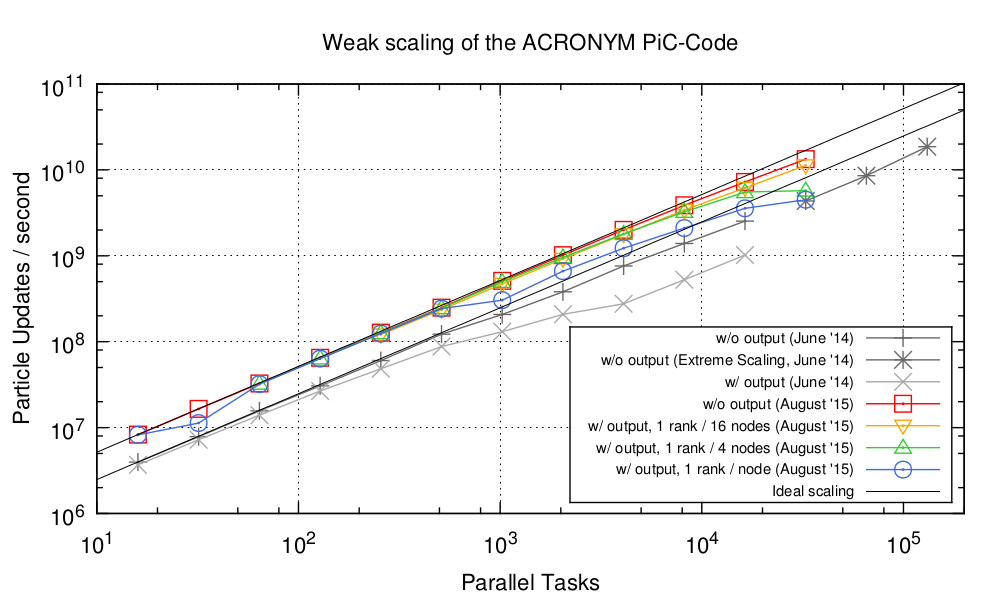Lecture 6: Particle-in-cell – hands-on
Institute for Physics and Astronomy, University of Potsdam
November 28, 2024
1 Lecture overview
Table of Contents 1/2
- 17.10. Introduction + numerical methods summary
- 24.10. Numerical methods of differential equations — lecture + hands-on
- 31.10. State holiday
- 07.11. Test particle approach — lecture
- 14.11. Test particle approach — lecture + hands-on
- 21.11. PIC method — lecture
- 28.11. PIC method — hands-on
Table of Contents 2/2
- 05.12. Fluid and MHD — lecture (online)
- 12.12. Fluid and MHD — hands-on ?
- 19.12. Canceled
- 09.01. Radiative transfer — lecture + hands-on
- 16.01. HPC computing — lecture + hands-on
- 23.01. Advanced — Smooth particle hydrodynamics method — lecture
- 30.01. Advanced — Hybrid, Gyrokinetics — lecture
- 06.02. Advanced — Vlasov and Linear Vlasov dispersion solvers — lecture
1.1 Fluid vs Kinetic plasma models
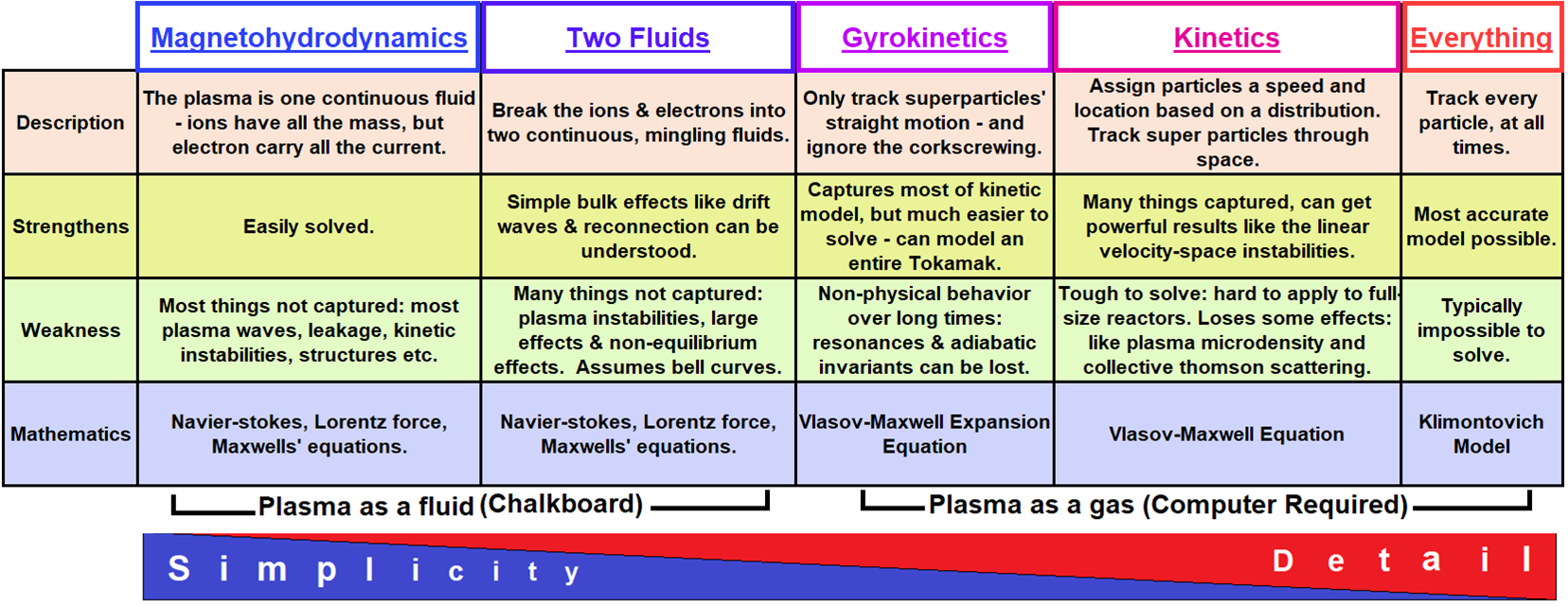
Range of validity of different plasma codes based on typical magnetospheric parameters: \(n=50cm^{-3}\), \(B=50 nT\), \(T_e=T_i=100 eV\) (Winske and Omidi (1996)).
2 Fully-kinetic/Vlasov description - Particle in cell model
2.1 Fully-kinetic/Vlasov description - PIC model
Full equations of motion
\[ \nabla\cdot\vec{E}(\vec{x},t)=\frac{\rho(\vec{x},t)}{\epsilon_0}\\ \nabla\cdot\vec{B}(\vec{x},t)=0\\ \nabla\times\vec{E}(\vec{x},t)=-\frac{\partial \vec{B}(\vec{x},t)}{\partial t}\\ \nabla\times\vec{B}(\vec{x},t)=\mu_0\vec{J}(\vec{x},t)+\mu_0\epsilon_0\frac{\partial \vec{E}(\vec{x},t)}{\partial t} \]
\[ \frac{dv_i}{dt}=\frac{q}{m}\left[\vec{E}(\vec{x}_i,t) + \vec{v}\times\vec{B}(\vec{x}_i,t) \right] \]
\[ \rho(\vec{x},t)=\sum\limits_{\alpha} q_{\alpha}\int\limits dv^3\,\sum_i\delta(\vec{x}-\vec{x_i})\delta(\vec{v}-\vec{v_i})\\ \vec{J}(\vec{x},t)=\sum\limits_{\alpha} q_{\alpha}\int dv^3\,\vec{v}\sum_i\delta(\vec{x}-\vec{x_i})\delta(\vec{v}-\vec{v_i}) \]
2.2 Fluid vs Kinetic plasma models
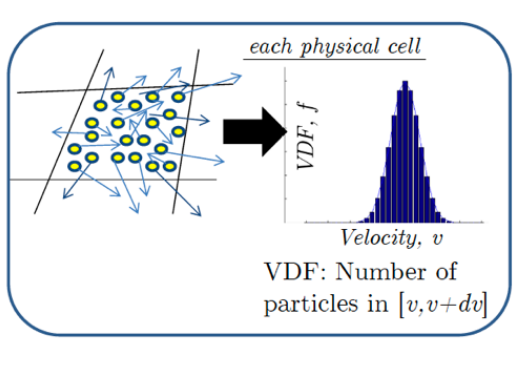
\(Kn\) is the Knudsen number, which indicates how collisional a plasma is. A collisionless plasma has \(K_n\gg1\).
2.3 A typical PIC loop
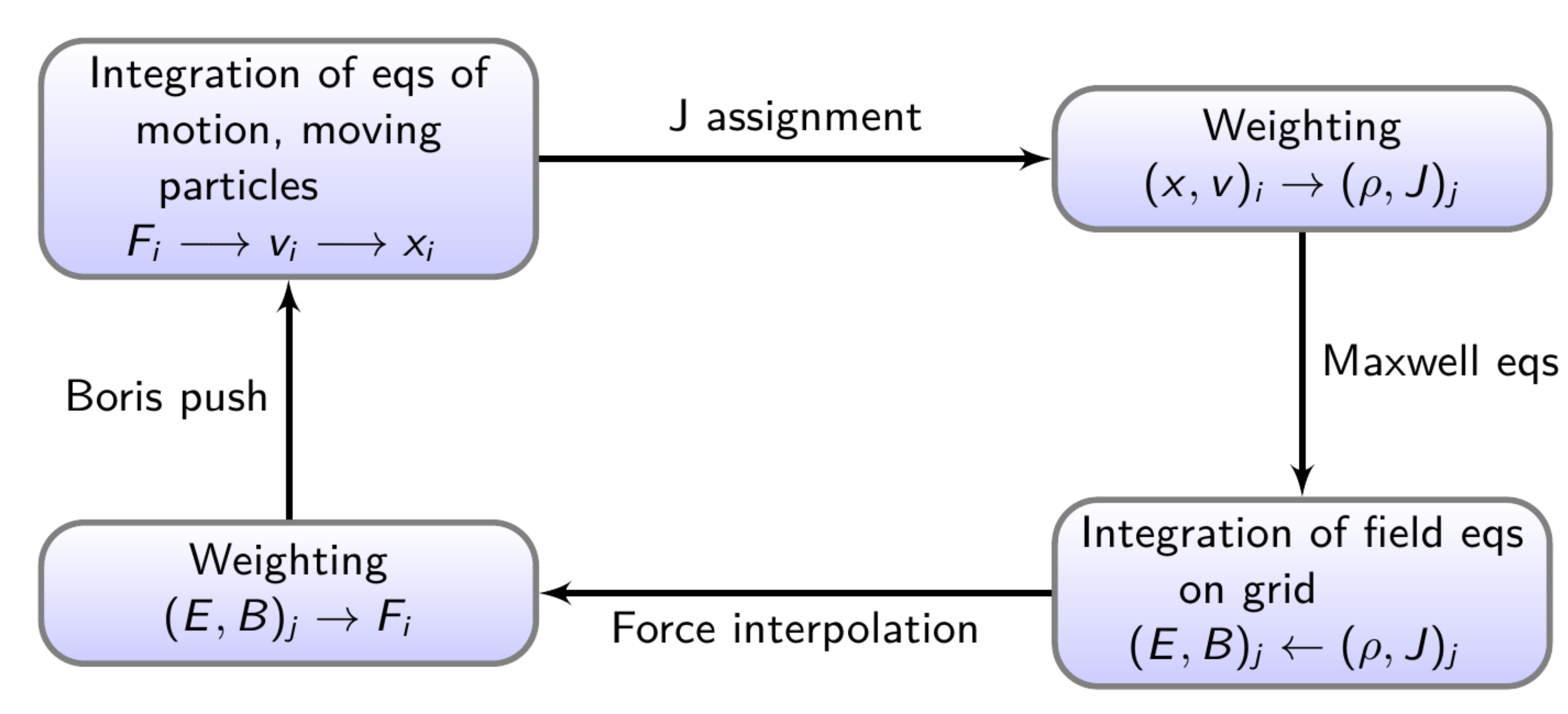
PIC loop.
2.4 Applications
2.5 Beam instabilities
2.6 Idea of micro-instability
- The linearized 1D electrostatic Vlasov eq is: \[ \frac{\partial f_1}{\partial t} + v\frac{\partial f_1}{\partial x} +\frac{e}{m_e}\frac{\partial \phi_1}{\partial x}\frac{\partial f_0}{\partial v}=0 \]
- Necessary condition for instability: \[ \left.\frac{\omega}{k}\frac{\partial f_0}{\partial v}\right|_{v=\omega/k}>0 \]
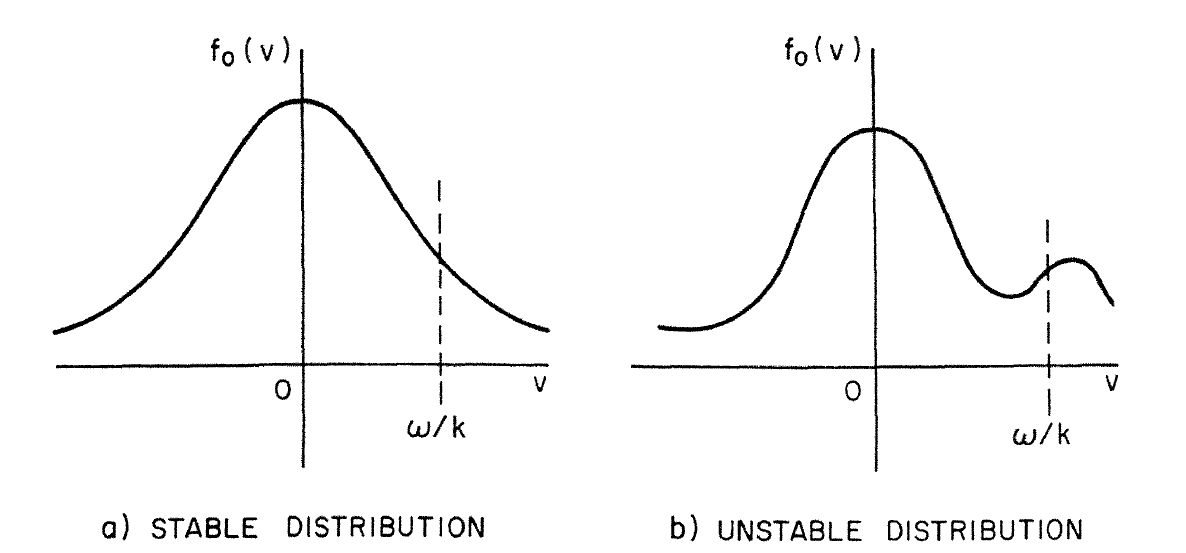
2.7 Two-stream instability
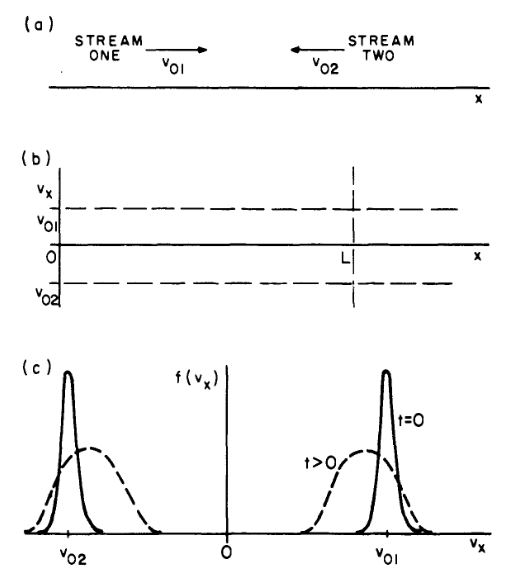
Setup of the two-stream instability (Birdsall and Langdon (1991)).
2.8 Two-stream instability
- Two counter-propagating streams with similar density Dawson (1962).
- This system is unstable because any density perturbation in one stream is reinforced by the forces due to the bunching of particles in the other stream, so the perturbation grows exponentially in time \(\Delta n_1\propto n_1\).
- Dispersion relation (from fluid eqs. or Vlasov with \(\delta\) distributions): \[ \frac{\epsilon}{\epsilon_0} = 1 - \frac{\omega_{p1}^2}{(\omega- \vec{k}\cdot\vec{V}_{01})^2} - \frac{\omega_{p2}^2}{(\omega- \vec{k}\cdot\vec{V}_{02})^2} \]
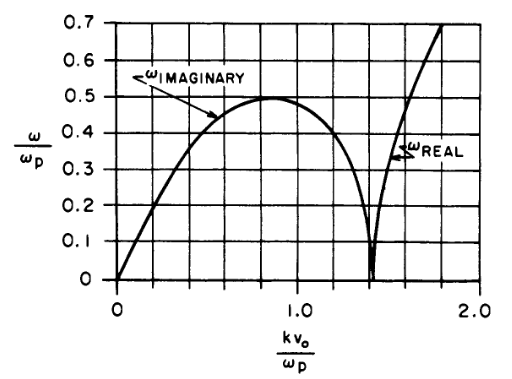
\(\Omega\) and \(\gamma\) of the two-stream instability (Birdsall and Langdon (1991)).
2.9 Two-stream instability simulation
https://www.youtube.com/watch?v=__7GQS15IdE
(https://aip.scitation.org/doi/10.1063/1.3493627)
2.10 Two-stream instability
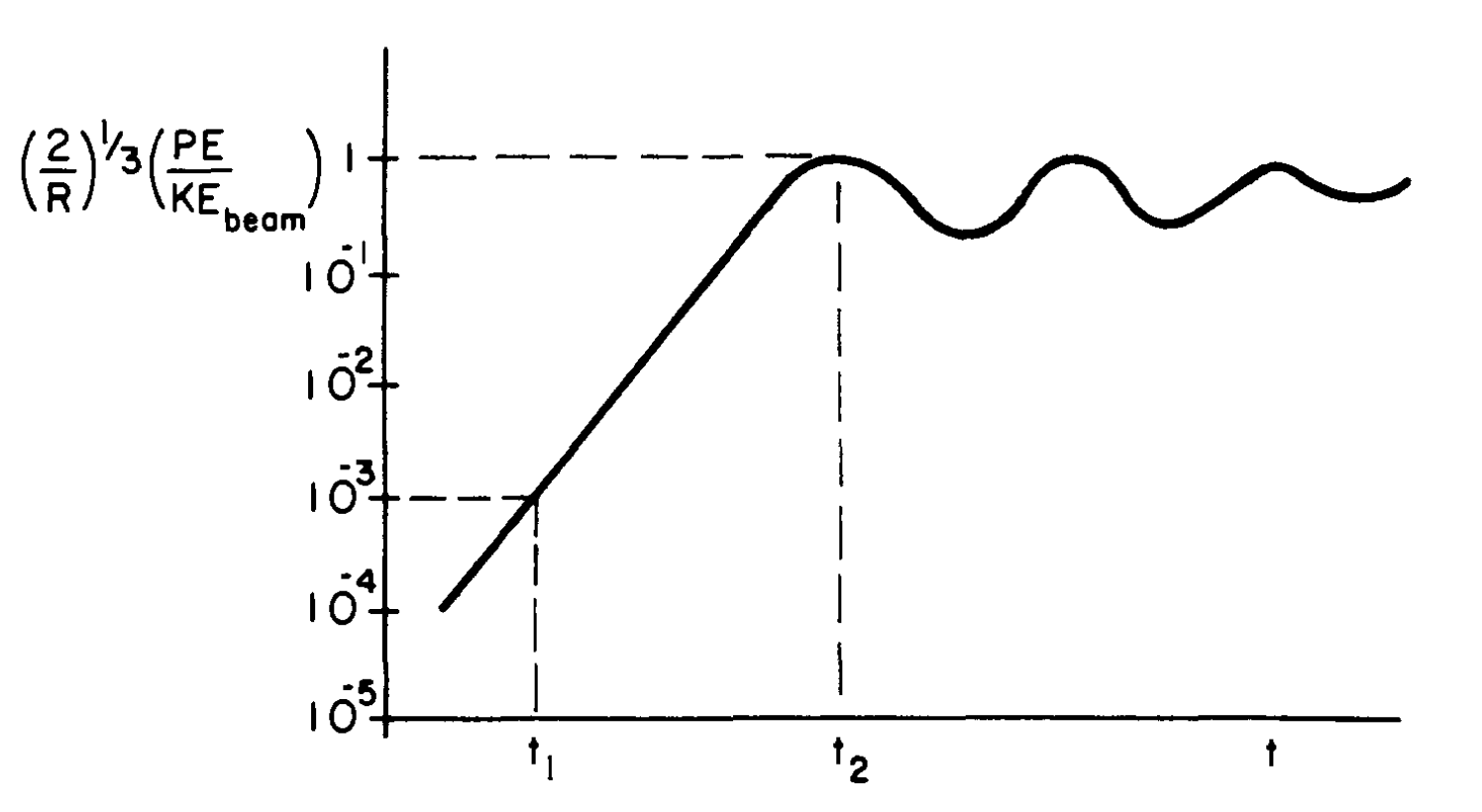
Saturation of the two-stream instability (Birdsall and Langdon (1991)).
2.11 Two-stream instability
- As the instability grows, the temperature of each beam increases and the drift/mean velocity decreases.
- The condition for linear growth is \(v_{drift}> 1.3 v_{th}\), but it is observed that growth continues even below this threshold because of non-linear effects (trapping).
- Growth continues until the streaming is “thermalized”, when the distribution becomes Maxwellian.
- This thermalization is not due to collisions, but rather due to collective effects: build up of \(\vec{E}\) fields at long wavelengths which scatter particles in the phase space.
2.12 Application: solar radio bursts
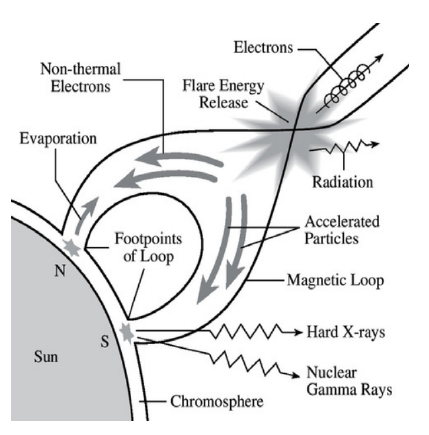

Lang et al. (2010), Reiner and MacDowall (2019)
2.13 Application: pulsar radio emission
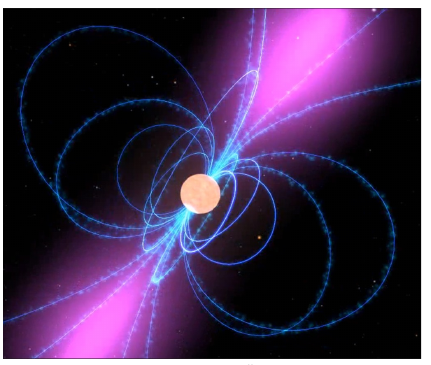
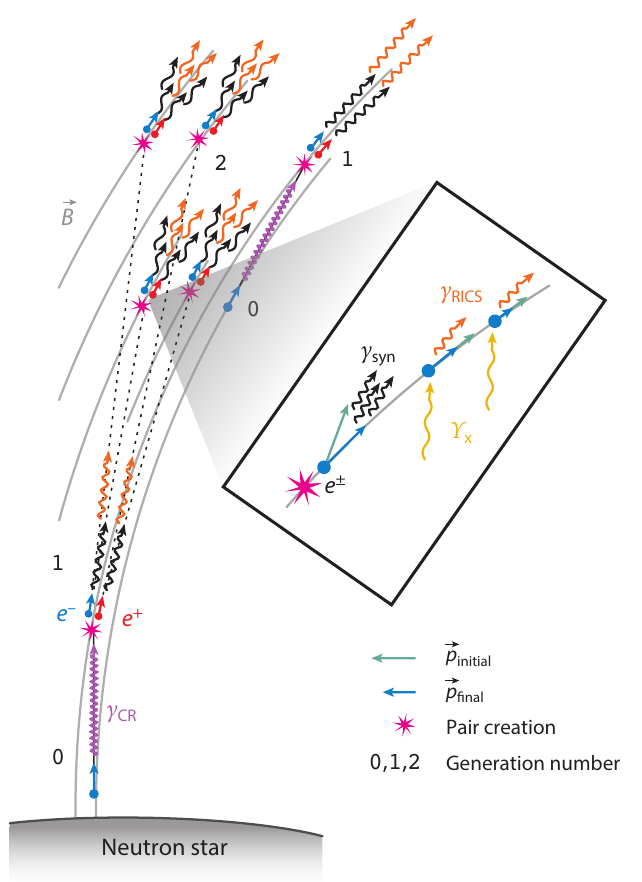
NASA, ESO, Timokhin and Harding (2019)
2.14 Application: neutron star magnetospheres
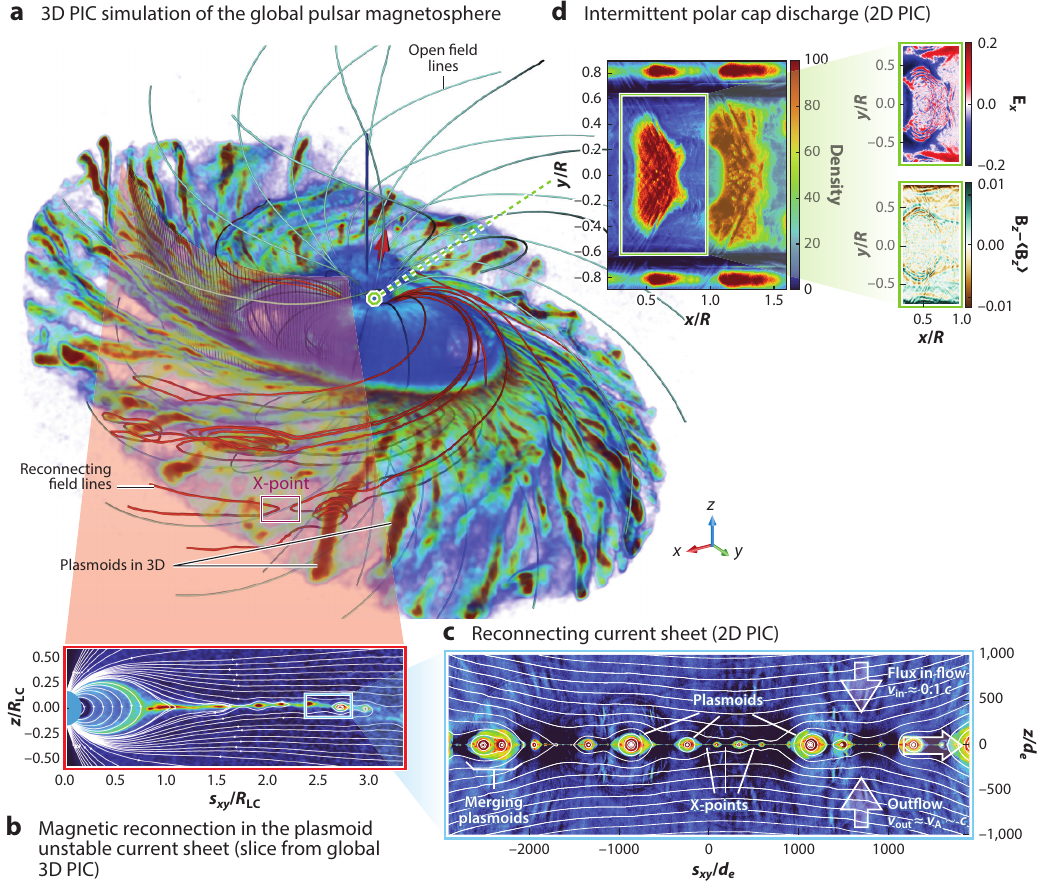
Philippov and Kramer (2022).
2.15 Application: black hole magnetospheres


Black hole event horizon, magnetic field lines, and plasma density (Crinquand et al. (2022), Philippov and Kramer (2022)).
2.16 Collisionless shocks
2.17 Astrophysical Shocks
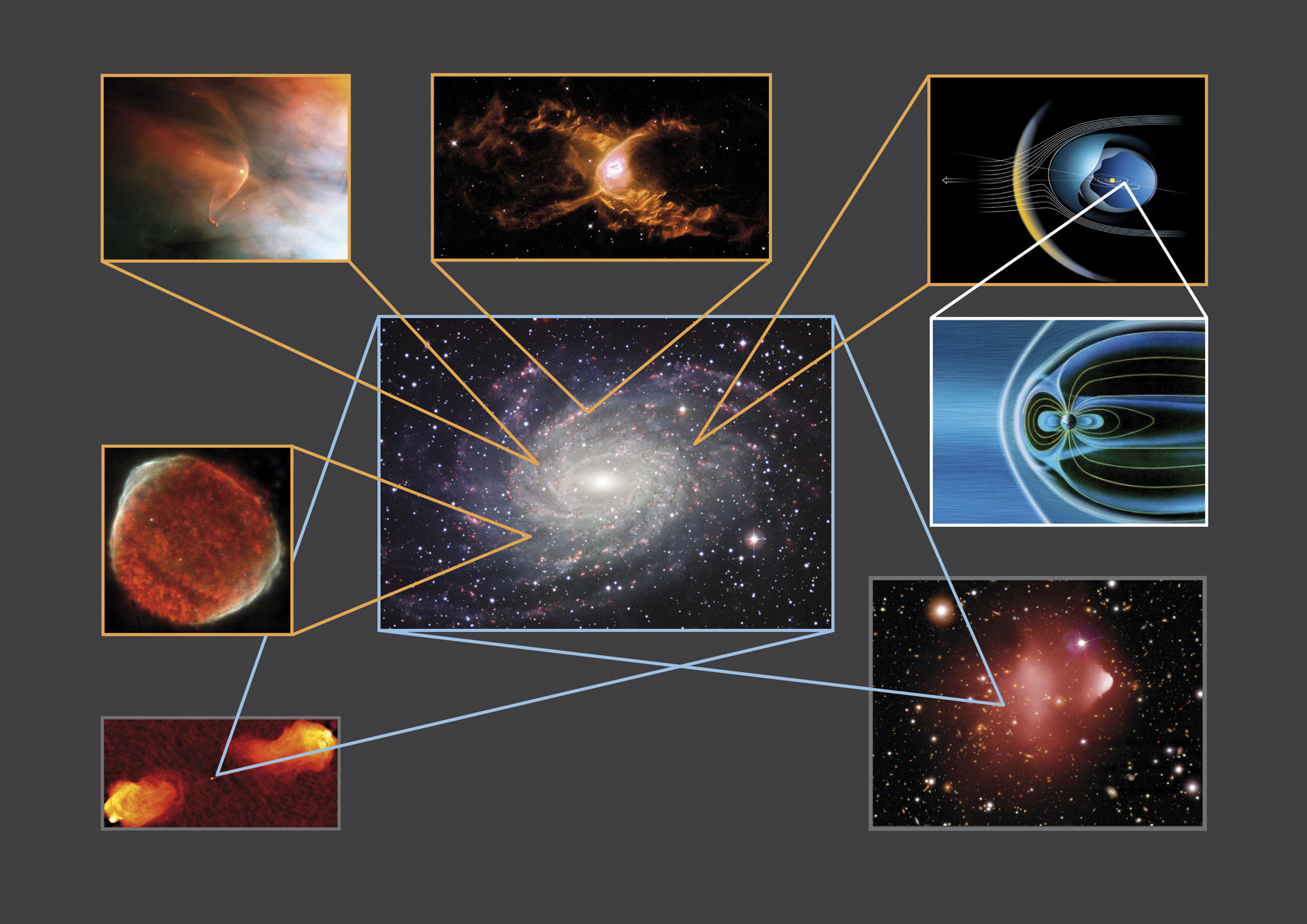
ESA: esa.int
2.18 Shock simulation
https://www.youtube.com/watch?v=j1WrS2dyRpw
(Reference paper: Murphy, Dieckmann, and Drury (2010)).
2.19 Shock features
Quasi-perpendicular 1D shock Marcowith et al. (2016).
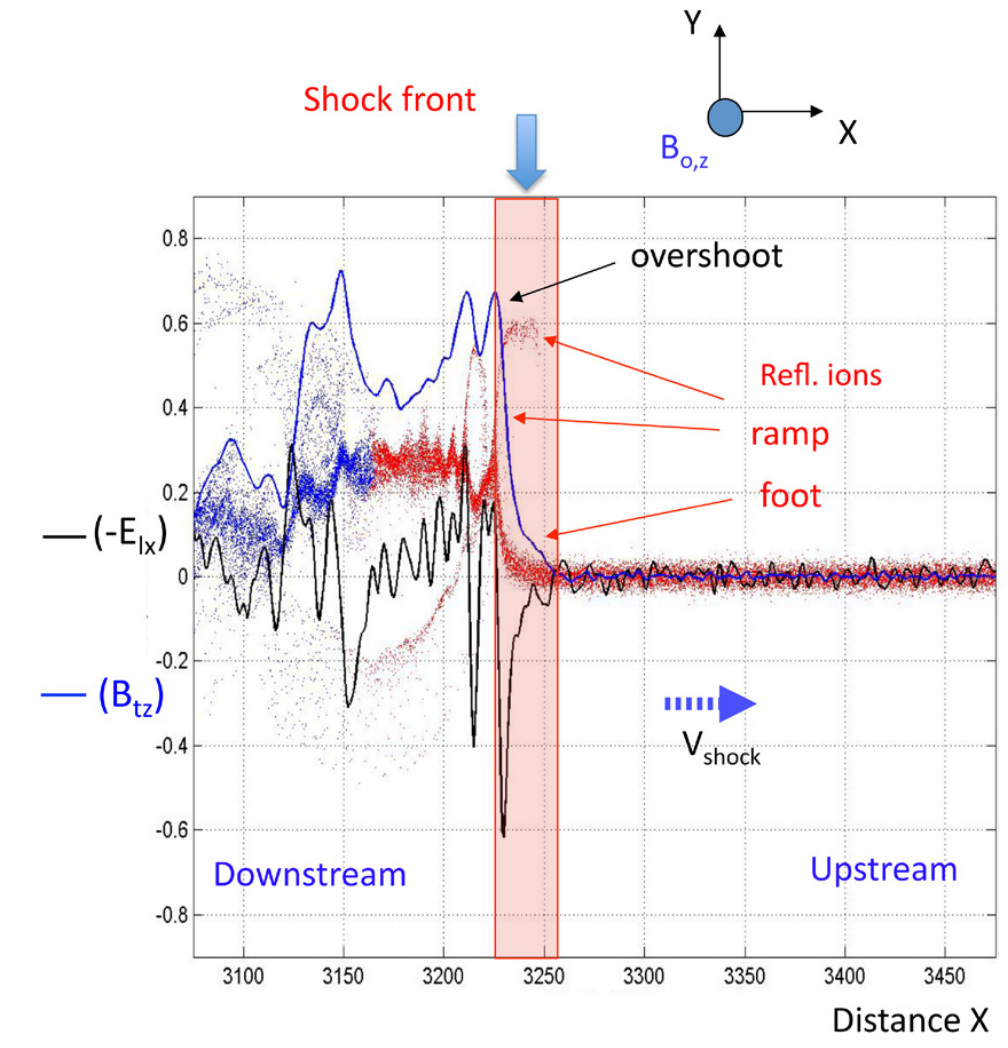
2.20 Magnetic reconnection
2.21 Magnetic reconnection
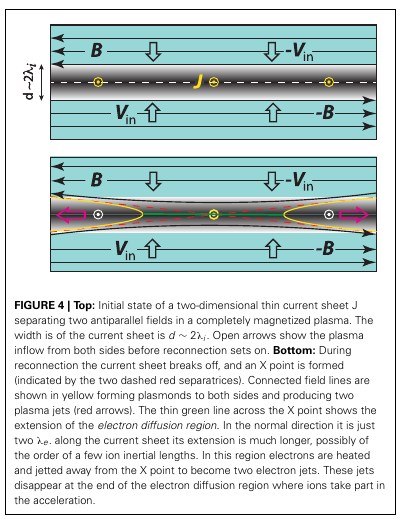
Initial setup (Treumann and Baumjohann (2013)).
2.22 Magnetic Reconnection


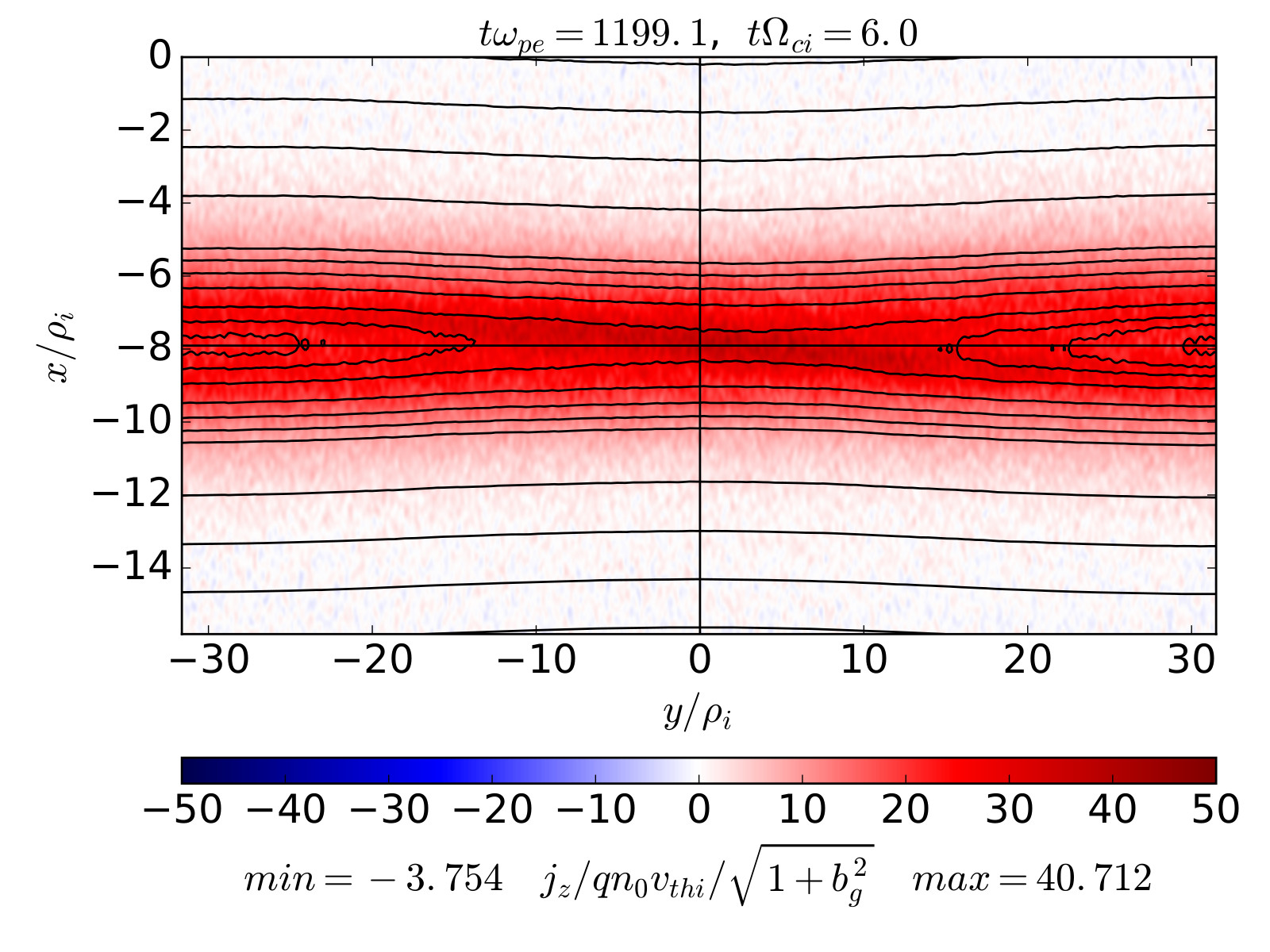
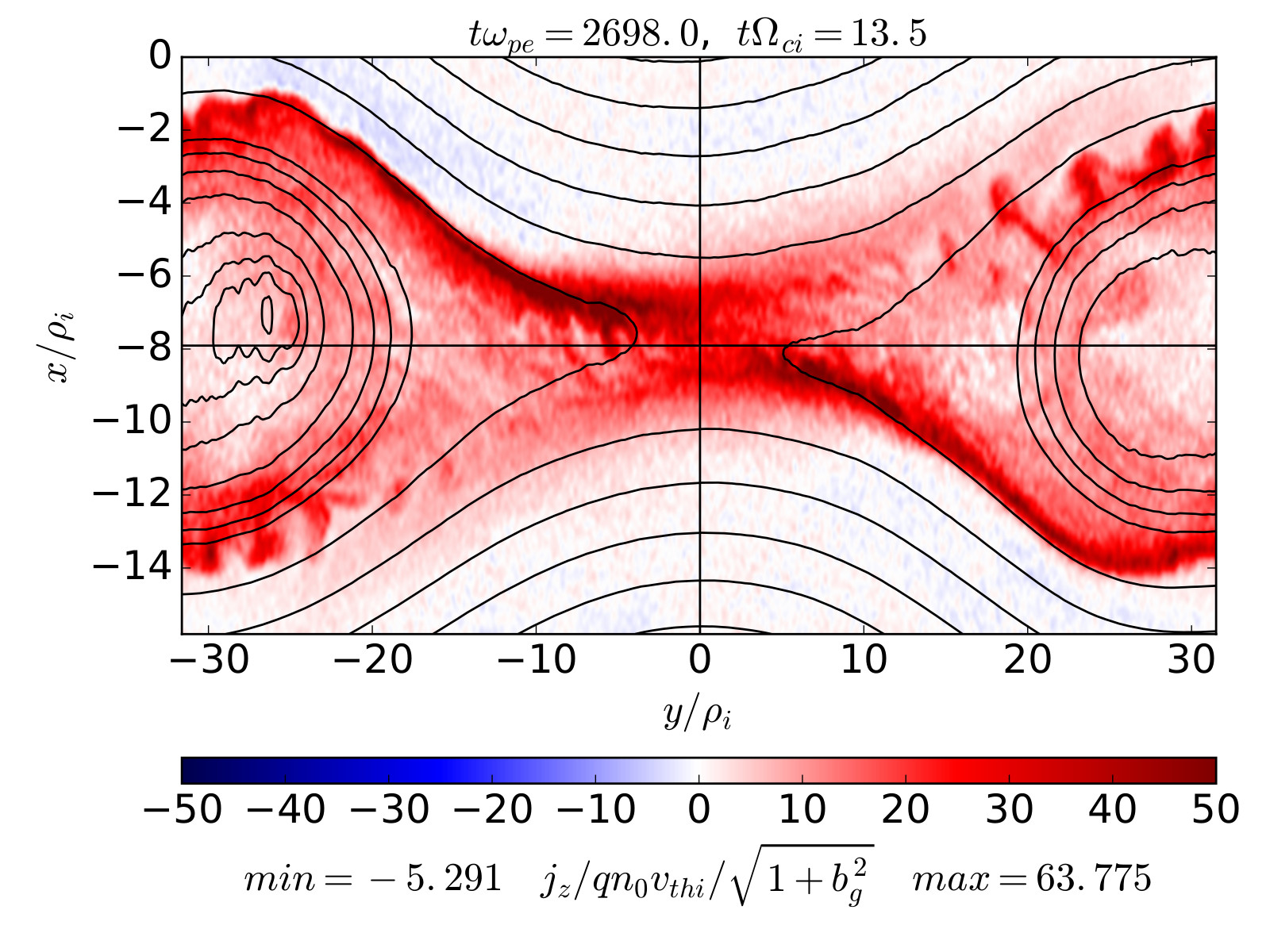
2.23 Magnetic reconnection
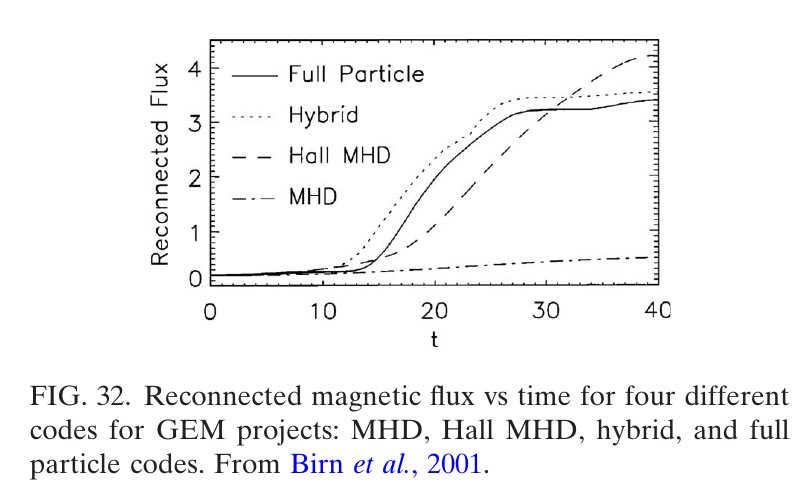
Birn et al. (2001).
2.24 Magnetic reconnection: Earth’s magnetosphere
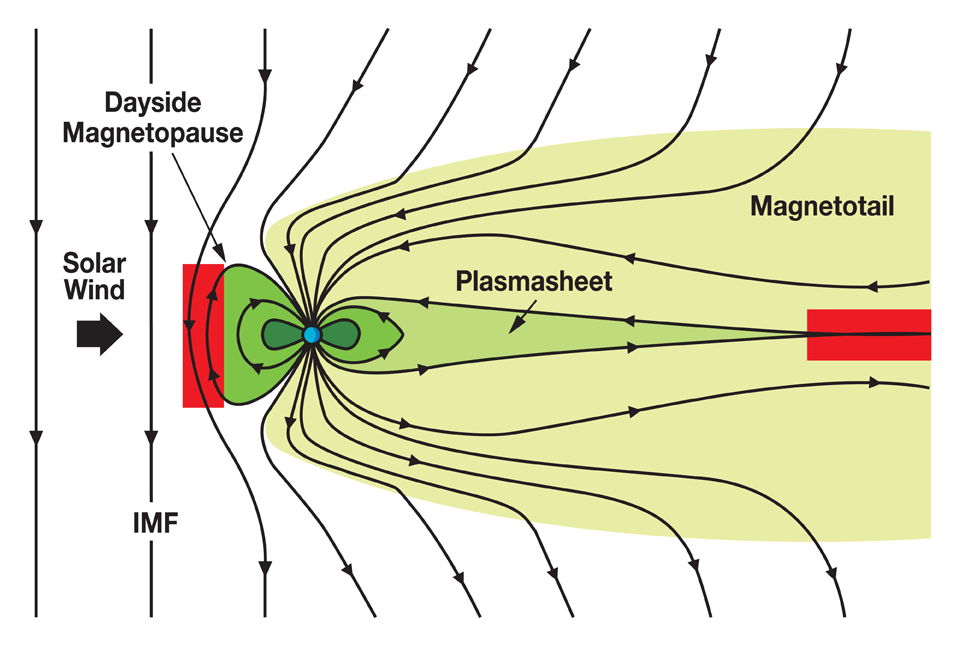
Treumann and Baumjohann (2013).
2.25 Magnetic reconnection: 3D effects
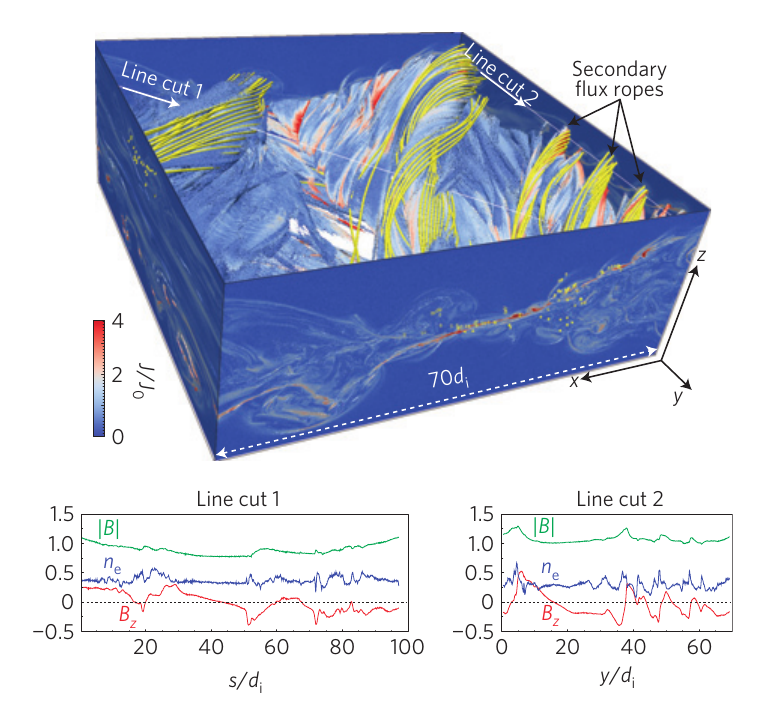
Daughton et al. (2011).
3 Conclusions
3.1 PIC code ACRONYM
- Our fully-kinetic PIC code is called ACRONYM: ``Another Code for pushing Relativistic Objects, Now with Yee lattice and Macro particles’’
- Applications: wave-wave interactions in type II and type III solar radio bursts (radio emission), CME driven shocks in the solar wind, resonant wave-particle interactions, current sheet instabilities and magnetic reconnection, kinetic turbulence, particle acceleration, pulsar radio emission.
![]()
- Published papers with this code in our group: Manthei et al. (2021), Benáček et al. (2021), Benáček, Muñoz, and Büchner (2021), Benáček et al. (2023)
3.2 Other PIC codes
- TRISTAN code: Buneman 1993, Terra Scientific
- Spitkovsky/Princeton’s Tristan-MP: https://github.com/ntoles/tristan-mp-pitp
- Zeltron: https://ipag.osug.fr/~ceruttbe/Zeltron/index.html
- UCLA’s skeleton PIC codes: https://github.com/UCLA-Plasma-Simulation-Group/PIC-skeleton-codes
- Los Alamos’s VPIC: https://github.com/lanl/vpic
- LLNL/LBNL’ Warp: http://warp.lbl.gov/home
- Lapenta/Leuven’s iPic3D: https://github.com/CmPA/iPic3D
- UK’s EPOCH: https://gitlab.com/arm-hpc/packages/wikis/packages/EPOCH
- HZDR’s PIConGPU: https://github.com/ComputationalRadiationPhysics/picongpu
3.3 Bachelor/Master projects:
Investigating magnetospheres of neutron stars:

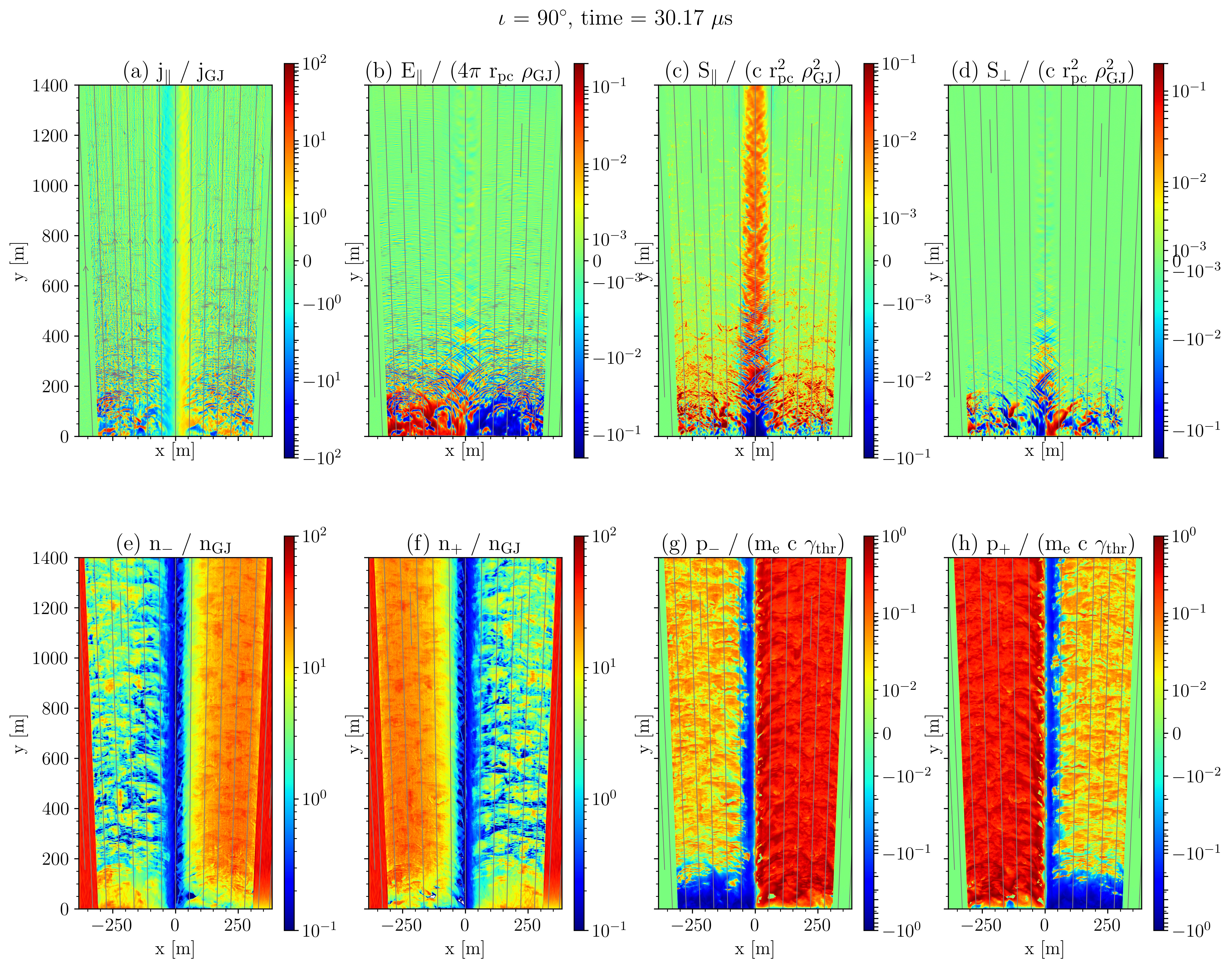
Benáček et al. (2023, in prep.)
